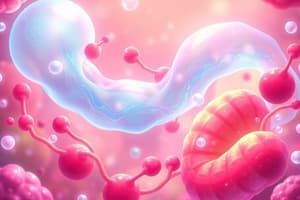Podcast
Questions and Answers
Describe the structure of a lipid molecule.
Describe the structure of a lipid molecule.
Lipids are composed of a glycerol molecule linked to fatty acids. The fatty acids can be saturated or unsaturated, and they determine the physical properties of the lipid. Additionally, lipids may contain other functional groups, such as phosphates.
What are lipids and what is their role in biochemistry?
What are lipids and what is their role in biochemistry?
Lipids are a class of organic compounds that are insoluble in water. They play a crucial role in biochemistry as they serve as an energy source, provide insulation, act as structural components of cell membranes, and serve as signaling molecules.
Explain the process of lipid metabolism in the body.
Explain the process of lipid metabolism in the body.
Lipid metabolism involves the digestion, absorption, and utilization of dietary fats. After digestion, the fatty acids and glycerol are absorbed into the bloodstream and transported to various tissues. Once in the cells, lipids are either oxidized for energy production or stored as triglycerides in adipose tissue for later use.
Flashcards are hidden until you start studying
Study Notes
Structure of Lipid Molecule
- Lipid molecules consist of a glycerol backbone and three fatty acid chains, usually identical and unbranched, attached to it
- Fatty acid chains are hydrophobic (non-polar) and can vary in length, saturation, and unsaturation, affecting the lipid's properties
What are Lipids and their Role in Biochemistry?
- Lipids are a class of biomolecules that are insoluble in water, consisting of fatty acids, oils, waxes, and steroids
- They play a crucial role in energy storage, cell membrane structure, and hormone regulation
- Lipids are involved in the absorption of fat-soluble vitamins (A, D, E, and K) and can be used as a source of energy when carbohydrates are not available
Lipid Metabolism in the Body
- Lipid metabolism involves the breakdown (catabolism) and synthesis (anabolism) of lipids in the body
- Lipids are digested in the small intestine into fatty acids and glycerol, which are then absorbed into the bloodstream
- In the liver, fatty acids are either oxidized to produce energy or re-synthesized into triglycerides for storage in adipose tissue
- Lipids are transported through the bloodstream as lipoproteins, which are classified as HDL (high-density lipoprotein), LDL (low-density lipoprotein), and VLDL (very-low-density lipoprotein) based on their density and composition
Studying That Suits You
Use AI to generate personalized quizzes and flashcards to suit your learning preferences.




